Aloe castanea
Aloe castanea Schönland
Family: Asphodelaceae
Common names: cat's tail aloe (Eng.), katstertaalwyn (Afr.), borolo, suwopa, sekgopha (Northern Sotho)
Introduction
An attractive, large aloe that occurs in savanna and grassland, with very distinctive spreading branches and snake-like Inflorescences; and flowers filled with dark brown nectar, a characteristic shared by few other aloes.
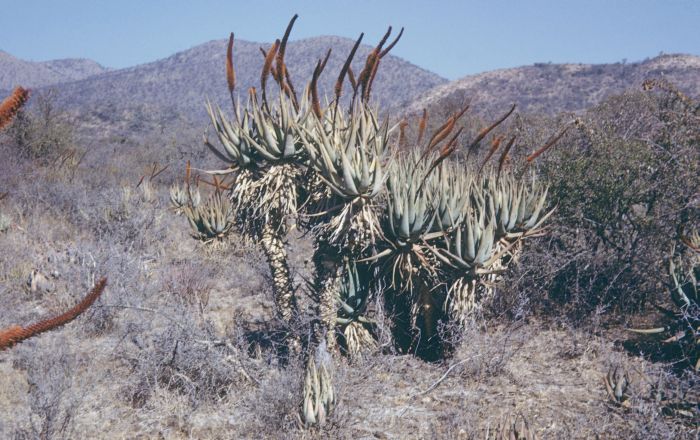
Description
Description
Aloe castanea is a perennial, evergreen, low growing, arborescent (tree-like) aloe or large shrub that grows 2 to 4 m tall, with a thick main stem, usually bare at the base, and multiple branches.
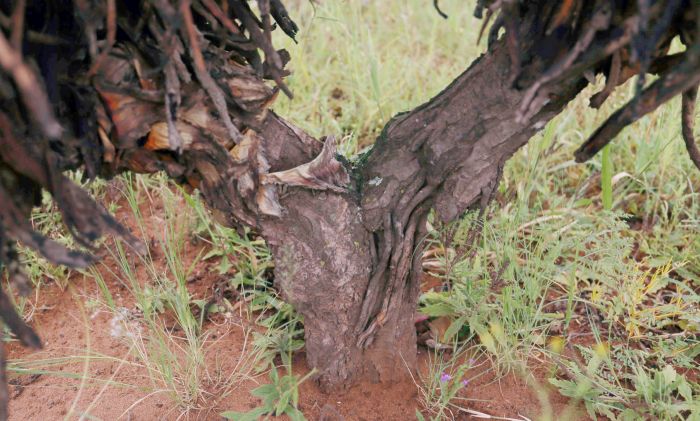
The stems are covered with dry leaves. The leaves are succulent, usually smooth both sides, bluish-green with toothed margins, growing up to 1 m long and forming a rosette around the stem.
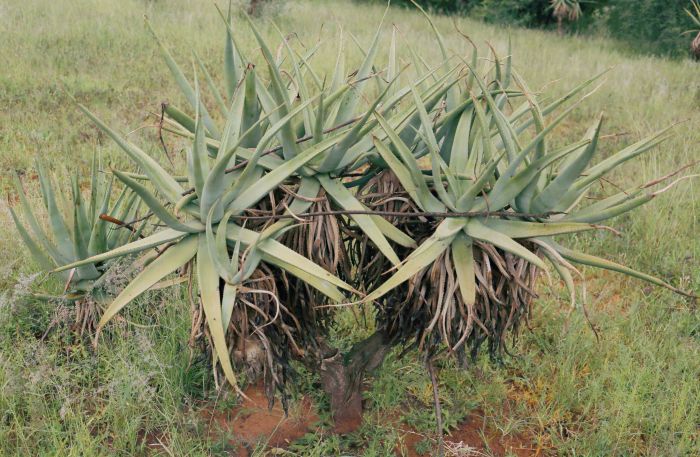
The inflorescence is a very long, simple spike, a single, unbranched flower stalk, up to 1 m long, with reddish brown, cup-shaped flowers that produce copious dark brown nectar. Usually producing 1 to 5 flower heads per rosette and the flower heads are usually crooked or carried at an angle with the tip pointing upwards. Fruit is a capsule, dehiscent when ripe.
In some, usually mature plants, a callus and aerial roots may form at the base of a branch, at the node.
Conservation Status
Status
Aloe castanea is a common species with very wide distribution and is assessed as Least Concern (LC) on the Red List of South African plants. No threats have been recorded.

Distribution and habitat
Distribution description
Aloe castanea is widespread in 2 provinces in the north eastern part of South Africa: Mpumalanga, where it occurs mainly near Lydenburg and Emalahleni, and in Limpopo, where it occurs mainly in Polokwane, Sekhukhune and Steelpoort. This species is normally found in dry bushveld, on rocky outcrops, sometimes in flat open grassland, in savanna and grassland, in well-drained soil. The summers are hot, and winters are cool with light frost, and the region normally receives rainfall in summer and experiences a dry winter.
Derivation of name and historical aspects
History
The genus name Aloe is derived from the Semitic word alloeh, meaning ‘bitter’ and the name refers to the bitter juice found in the leaves of aloes. The specific epithet castanea is the genus name for the chestnuts, a group of deciduous trees and shrubs with edible fruits, the best known species being the sweet chestnut (Castanea sativa). The name originates from the ancient Greek word κάστανον (kastaneia), meaning ‘chestnut’ and in this case it refers to the brown nectar in the flowers of Aloe castanea, or to its ‘chestnut brown’ flowers. The common name cat's tail aloe or katstertaalwyn, refers to the appearance of the inflorescences.
The family Asphodelaceae has over 20 genera, including Aloidendron, Astroloba, Gasteria, Haworthiopsis, Haworthia, Kumara, Tulista and Bulbine, to name a few. The genus Aloe occurs in about 40 countries, mainly in Africa, Arabian Peninsula, Madagascar and eastern Indian Ocean Islands. Aloe has about 615 taxa, of that about 1 155 taxa (including subspecies and varieties) and about 140 species occur in southern Africa.
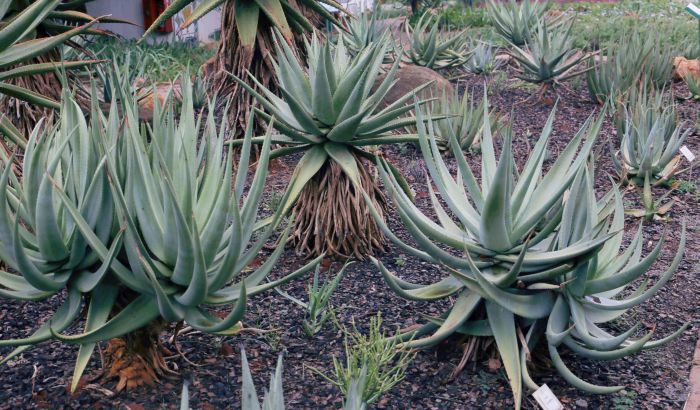
Ecology
Ecology
Aloe castanea starts flowering in early winter (May–July) and continues to early spring (August); the flowers are rich in nectar and are visited by many insects, including honey bees, and nectar-feeding birds, such as sunbirds, which depend on this plant for food. The flowers are pollinated by sunbirds and bees. When the fruits are ripe the capsules dry, and split open to release the seeds. Seeds are dispersed by wind in spring, and banked in the soil during summer season and winter, start germinating in following summer (November-December).
Aloe castanea is well adapted to hot and dry conditions, with succulent leaves that help it to survive long dry seasons. This species has a strong stem and root system to support its heavy crown. This species often occurs in rocky outcrops in bushveld, which protect young seedlings during hot and dry seasons, and from grass fires. This species grows well in a wide range of soil types and conditions.
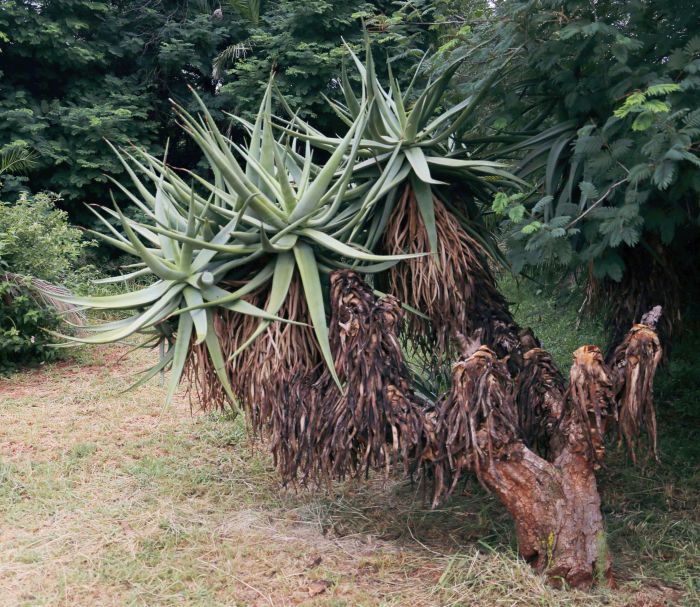
Uses
Use
The concept of water-wise gardening, and using succulent plants for landscaping, has become common over the last few years, and this species is a drought-tolerant garden plant and a good choice for water-wise planting. It is also a striking, shapely plant that can be used in landscape design.
Although many aloes, such as Aloe ferox, A. vera, A. arborescens, A. aristata, A. cooperi and A. maculata are used for medicine and cosmetics, this species was mainly used as a preservative for grain; ashes from the burned leaves were used to dust the grain for long term storage in pits.
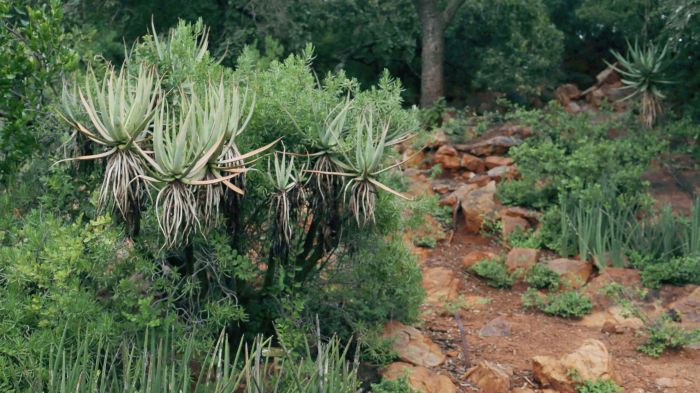
Growing Aloe castanea
Grow
Aloe castanea grows very well in cultivation and is suitable for rockeries and water-wise gardens, where the winter is cool with light frost or no frost, and also as a pot plant, using a large pot. It grows well in full sun and must be planted in a well-drained soil. During hot weather, water once a week and twice a month in normal summer temperatures, and once a month in winter. When mature plants are removed from the soil, or are being transplanted into bigger pots, leave the plant out of the soil for 2 to 3 days to dry and cut off the old roots to prevent rotting of the root system and promote growth of new roots.
Aloe castanea can be propagated using both sexual (seed sowing) and asexual (stem cutting) propagating methods. Sow seed in the warm months (mainly August-September), on coarse river sand and slightly cover the seeds with a layer of sand, not more than 2 mm deep, and keep the medium moist. Seeds germinate after 3 to 4 weeks. Transplant the seedlings 2 to 4 months after germination. Seedlings must be transplanted into a medium consisting of 2 parts coarse river sand and 1 part of well-rotted compost. Asexual propagation is done with leaf and stem cuttings removed using a clean, sharp instrument. Allow the cuttings to dry in a cool, airy place, away from direct sunlight, for a few days, until the cut ends have dried and dust the wounds with a fungicide. Plant the cuttings in a well-drained potting medium, in a lightly shaded, cool area, with high relative humidity. Keep moist but not wet. Where possible, for stem cuttings, cut at the base of the branch to get better rooting rate and rooting percentage.
Aloe castanea is prone to gall mite (aloe cancer), white scale, aphids, rust and they can be controlled by a fungicide or pesticide application. Prevent plant infection by sterilising your growing medium, tools, use only disease-free seeds, and also monitor pests and control them at an early stage to prevent spreading. Remove and dispose plants infested with gall mite, as it is difficult to treat it.
References
- Clarke, H. & Charters, M. 2016. The illustrated dictionary of southern African plant names. Flora & Fauna Publications Trust, Jacana, Johannesburg.
- Fox, F.W. & Norwood Young, E. 1982. Food from the veld: edible wild plants of southern Africa. Delta Books, Cape Town.
- Jeppe, B. 1969. South African aloes. Purnell, Cape Town.
- Mucina, L. & Rutherford, M.C. (eds) 2006. The vegetation of South Africa, Lesotho and Swaziland. Strelitzia 19. South African National Biodiversity Institute, Pretoria.
- Palmer, E. & Pitman, N. 1972. Trees of southern Africa. Balkema, Cape Town.
- Reynolds, G.W. 1950. The aloes of South Africa. Trustees of the Aloes of South Africa Book Fund, Johannesburg.
- Smith, G.F. & Van Wyk, B. 2008. Aloes in southern Africa. Struik, Cape Town.
- von Staden, L. 2009. Aloe castanea Schönland. National Assessment: Red List of South African Plants version 2017.1. Accessed on 2020/02/18
- Van Wyk, B. & Smith, G.F. 2003. Guide to the aloes of South Africa. Briza Publications, Pretoria.
Credits
Ntuthuko Mabuya and Zenani Nomgcino Petunia Mayisela
Pretoria National Botanical Garden
March 2020
Acknowledgements: the authors acknowledge L. Henderson and G.W. Reynolds for habitat photographs, and R.R Klopper for providing the images.
Plant Attributes:
Plant Type: Shrub, Succulent
SA Distribution: Limpopo, Mpumalanga
Soil type: Sandy, Loam
Flowering season: Winter
PH:
Flower colour: Brown, Orange
Aspect: Full Sun
Gardening skill: Easy
Special Features:
Horticultural zones








Rate this article
Article well written and informative
Rate this plant
Is this an interesting plant?
Login to add your Comment
Back to topNot registered yet? Click here to register.